Abstract
Bile acid levels were measured in the sera, cerebrospinal fluid (CSF), and brain tissue of 10 patients immediately after death from fulminant hepatic (FHF). Serum bile acids in FHF were predominantly conjugated, and total bile acid levels were higher in all 10 patients than in normal controls (85.9 +/- SE 8.4 compared with 5.7 +/- 0.4 nmol/ml, P less than 0.001). Small but significant amounts could be detected in CSF (range 1.2-5.3 nmol total bile acid/ml) and brain biopsies (1.0-18.8 nmol/g wet weight) of FHF patients, whereas none could be detected in CSF and brain biopsies of patients dying without evidence of liver disease. There was no relationship between serum, CSF, or brain levels and duration of coma, or presence of cerebral oedema found in five FHF patients at necropsy. However, serum bile acid levels were similar in FHF to those found in chronic liver disease without encephalopathy and lower than those found to inhibit brain respiration in vitro. A primary role for these compounds in the pathogenesis of coma in FHF therefore seems unlikely.
Full text
PDF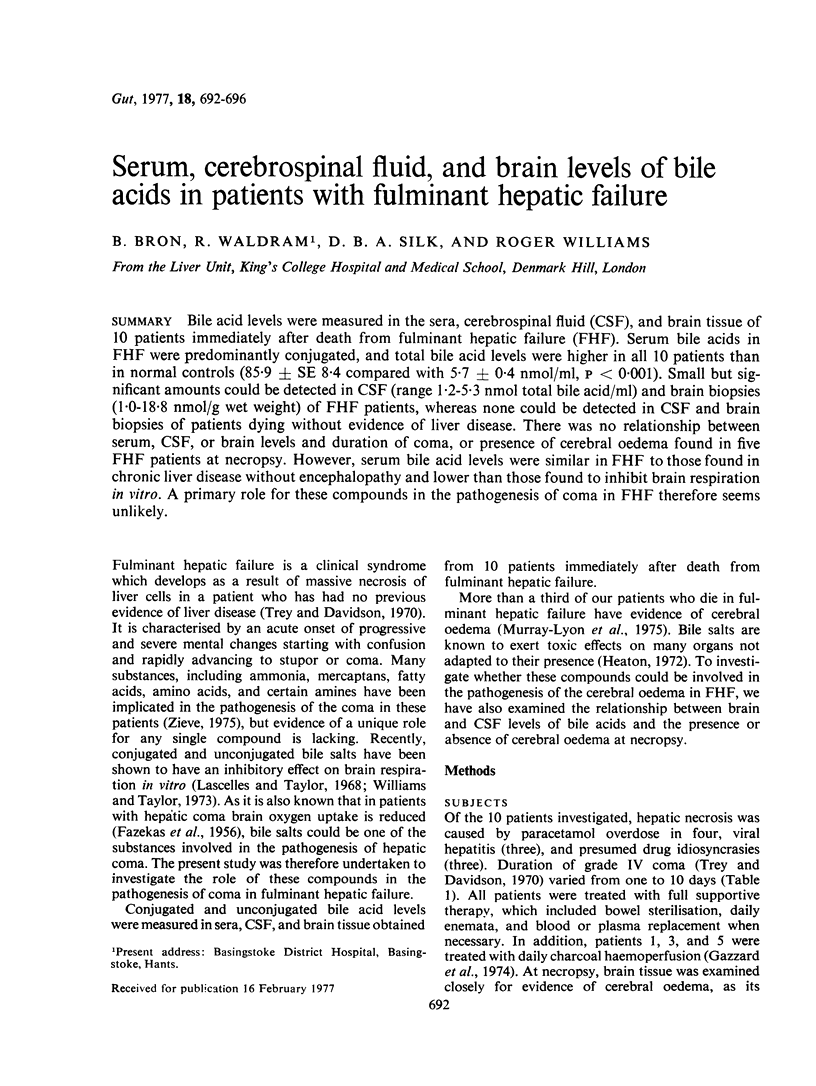
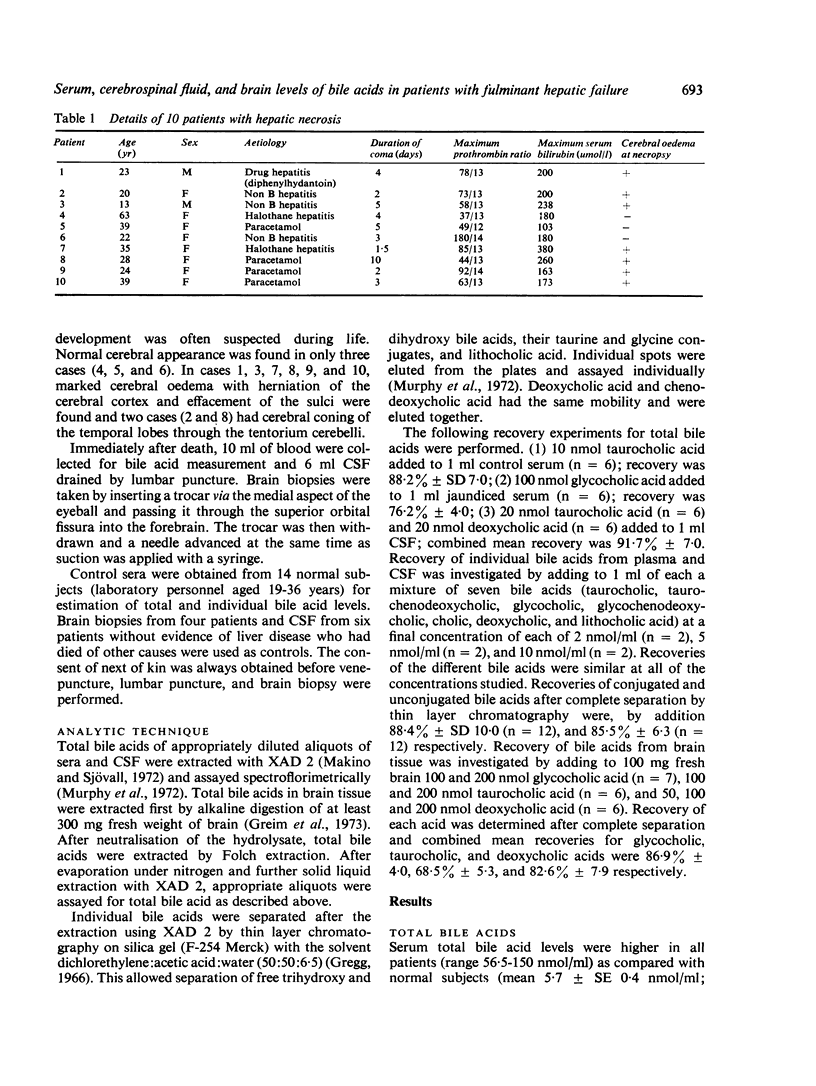
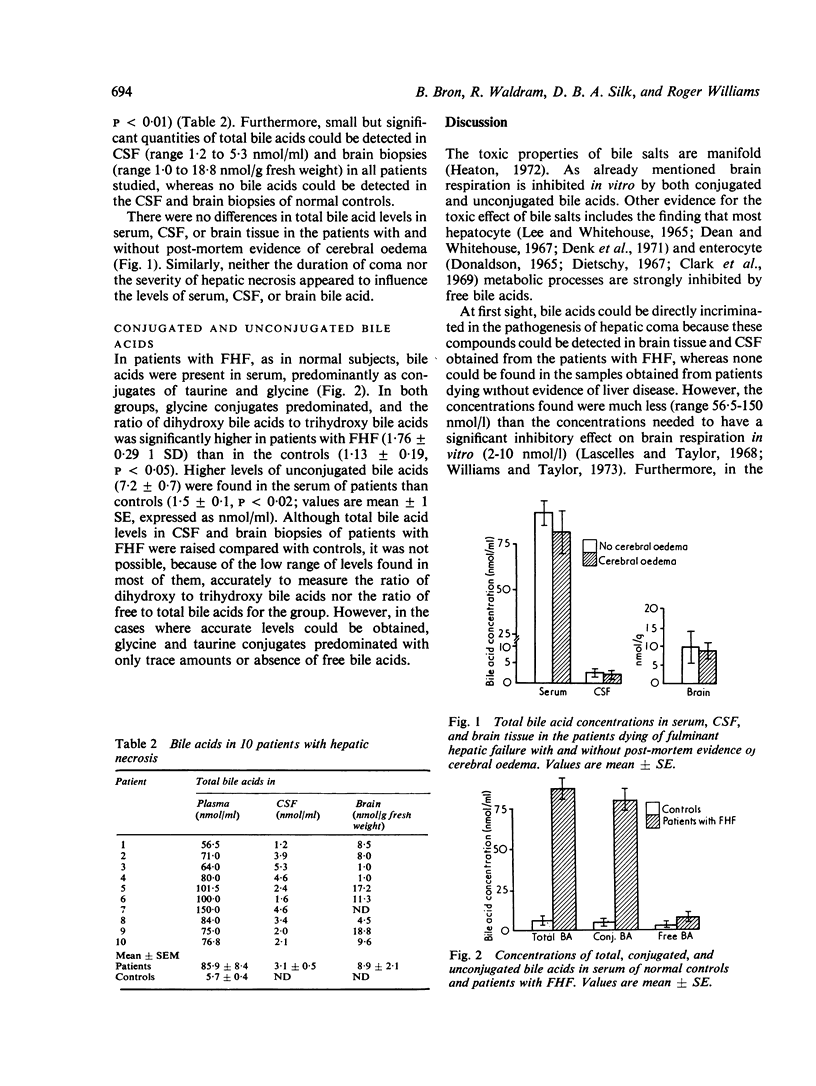
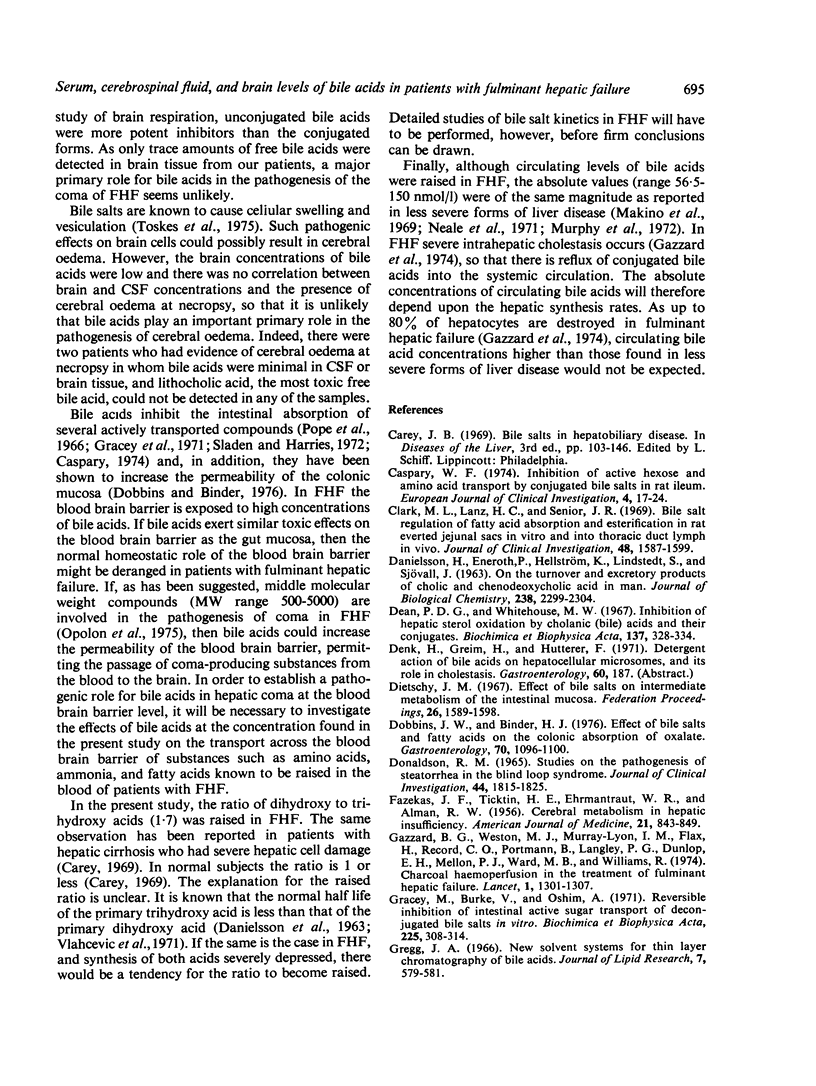
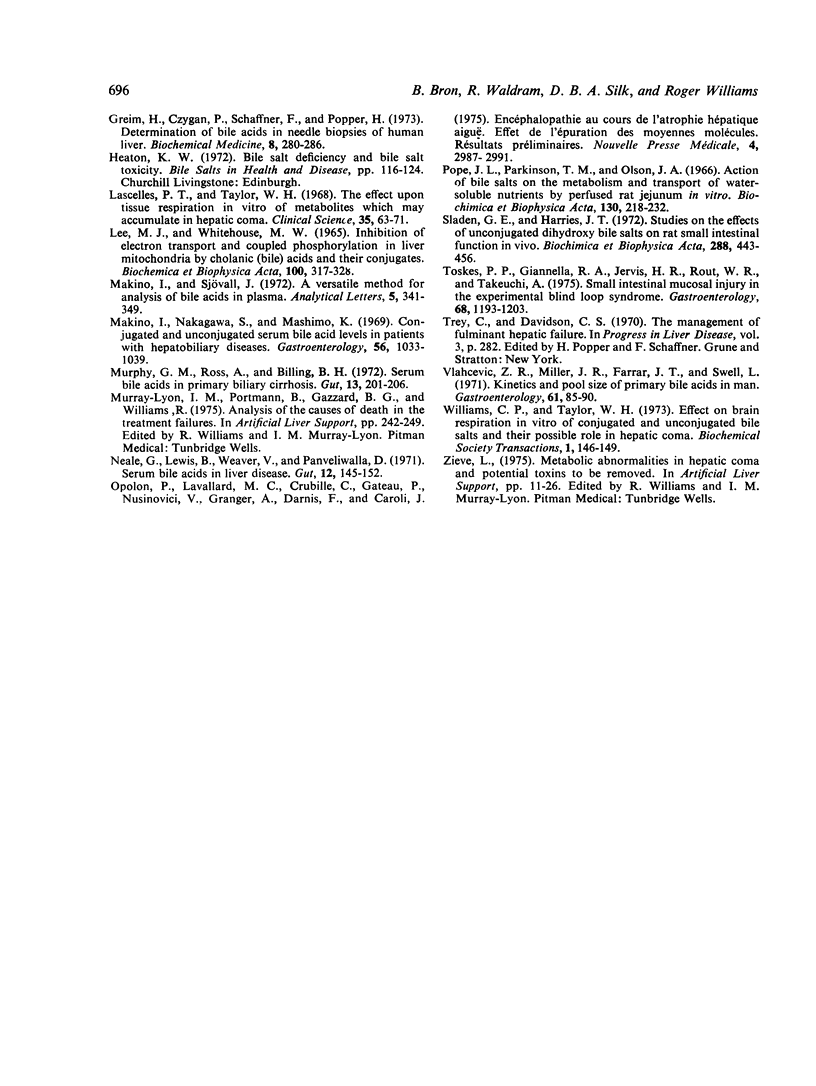
Selected References
These references are in PubMed. This may not be the complete list of references from this article.
- ALMAN R. W., EHRMANTRAUT W. R., FAZEKAS J. F., TICKTIN H. E. Cerebral metabolism in hepatic insufficiency. Am J Med. 1956 Dec;21(6):843–849. doi: 10.1016/0002-9343(56)90098-5. [DOI] [PubMed] [Google Scholar]
- Caspary W. F. Inhibition of active hexose and amino acid transport by conjugated bile salts in rat ileum. Eur J Clin Invest. 1974 Feb;4(1):17–24. doi: 10.1111/j.1365-2362.1974.tb00366.x. [DOI] [PubMed] [Google Scholar]
- Clark M. L., Lanz H. C., Senior J. R. Bile salt regulation of fatty acid absorption and esterification in rat everted jejunal sacs in vitro and into thoracic duct lymph in vivo. J Clin Invest. 1969 Sep;48(9):1587–1599. doi: 10.1172/JCI106124. [DOI] [PMC free article] [PubMed] [Google Scholar]
- DANIELSSON H., ENEROTH P., HELLSTROM K., LINDSTEDT S., SJOVALL J. On the turnover and excretory products of cholic and chenodeoxycholic acid in man. J Biol Chem. 1963 Jul;238:2299–2304. [PubMed] [Google Scholar]
- Dietschy J. M. Effects of bile salts on intermediate metabolism of the intestinal mucosa. Fed Proc. 1967 Nov-Dec;26(6):1589–1598. [PubMed] [Google Scholar]
- Dobbins J. W., Binder H. J. Effect of bile salts and fatty acids on the colonic absorption of oxalate. Gastroenterology. 1976 Jun;70(6):1096–1100. [PubMed] [Google Scholar]
- Donaldson R. M., Jr Studies on the pathogenesis of steatorrhea in the blind loop syndrome. J Clin Invest. 1965 Nov;44(11):1815–1825. doi: 10.1172/JCI105289. [DOI] [PMC free article] [PubMed] [Google Scholar]
- Gazzard B. G., Weston M. J., Murray-Lyon I. M., Flax H., Record C. O., Williams R., Portmann B., Langley P. G., Dunlop E. H., Mellon P. J. Charcoal haemoperfusion in the treatment of fulminant hepatic failure. Lancet. 1974 Jun 29;1(7870):1301–1307. doi: 10.1016/s0140-6736(74)90678-3. [DOI] [PubMed] [Google Scholar]
- Gracey M., Burke V., Oshin A. Reversible inhibition of intestinal active sugar transport by deconjugated bile salt in vitro. Biochim Biophys Acta. 1971 Feb 2;225(2):308–314. doi: 10.1016/0005-2736(71)90224-0. [DOI] [PubMed] [Google Scholar]
- Gregg J. A. New solvent systems for thin-layer chromatography of bile acids. J Lipid Res. 1966 Jul;7(4):579–581. [PubMed] [Google Scholar]
- Greim H., Czygan P., Schaffner F., Popper H. Determination of bile acids in needle biopsies of human liver. Biochem Med. 1973 Oct;8(2):280–286. doi: 10.1016/0006-2944(73)90032-x. [DOI] [PubMed] [Google Scholar]
- LEE M. J., WHITEHOUSE M. W. INHIBITION OF ELECTRON TRANSPORT AND COUPLED PHOSPHORYLATION IN LIVER MITOCHONDRIA BY CHOLANIC (BILE) ACIDS AND THEIR CONJUGATES. Biochim Biophys Acta. 1965 May 4;100:317–328. doi: 10.1016/0304-4165(65)90001-2. [DOI] [PubMed] [Google Scholar]
- Lascelles P. T., Taylor W. H. The effect upon tissue respiration in vitro of metabolites which may accumulate in hepatic coma. Clin Sci. 1968 Aug;35(1):63–71. [PubMed] [Google Scholar]
- Makino I., Nakagawa S., Mashimo K. Conjugated and unconjugated serum bile acid levels n patients with hepatobiliary diseases. Gastroenterology. 1969 Jun;56(6):1033–1039. [PubMed] [Google Scholar]
- Murphy G. M., Ross A., Billing B. H. Serum bile acids in primary biliary cirrhosis. Gut. 1972 Mar;13(3):201–206. doi: 10.1136/gut.13.3.201. [DOI] [PMC free article] [PubMed] [Google Scholar]
- Neale G., Lewis B., Weaver V., Panveliwalla D. Serum bile acids in liver disease. Gut. 1971 Feb;12(2):145–152. doi: 10.1136/gut.12.2.145. [DOI] [PMC free article] [PubMed] [Google Scholar]
- Opolon P., Lavallard M. C., Crubille C., Gateau P., Nusinovici V., Granger A., Darnis F., Caroli J. Encéphalopathie au cours de l'atrophie hépatique aiguë. Effet de l'épuration des moyennes molécules. Résultats préliminaires. Nouv Presse Med. 1975 Dec 6;4(42):2987–2991. [PubMed] [Google Scholar]
- Sladen G. E., Harries J. T. Studies on the effects of unconjugated dihydroxy bile salts on rat small intestinal function in vivo. Biochim Biophys Acta. 1972 Nov 2;288(2):443–456. doi: 10.1016/0005-2736(72)90265-9. [DOI] [PubMed] [Google Scholar]
- Toskes P. P., Giannella R. A., Jervis H. R., Rout W. R., Takeuchi A. Small intestinal mucosal injury in the experimental blind loop syndrome. Light- and electron-microscopic and histochemical studies. Gastroenterology. 1975 May;68(5 Pt 1):1193–1203. [PubMed] [Google Scholar]
- Trey C., Davidson C. S. The management of fulminant hepatic failure. Prog Liver Dis. 1970;3:282–298. [PubMed] [Google Scholar]
- Vlahcevic Z. R., Miller J. R., Farrar J. T., Swell L. Kinetics and pool size of primary bile acids in man. Gastroenterology. 1971 Jul;61(1):85–90. [PubMed] [Google Scholar]


